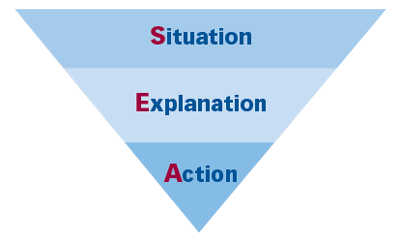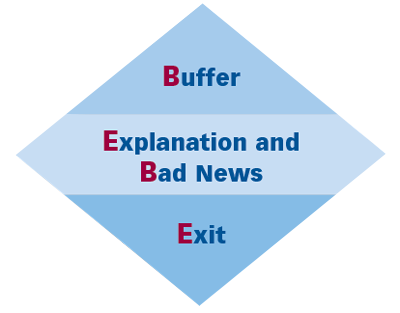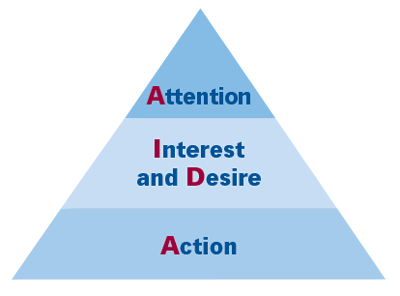2
Business Writing Trait 2: Organization
It’s no mistake that a business may also be called an organization. A business that is well organized will most likely be profitable, and a business that is poorly organized will most likely fail.
The same goes for communication. A well-organized message clearly and convincingly communicates its ideas, while a poorly organized message only confuses and frustrates the reader or listener.
Organization deals with the overall structure of a message, the order of its parts, and the transitions that tie it all together. This chapter focuses on organization, outlines specific problems with organization, and provides concrete solutions.
In this chapter
Organization: An Overview
Organization deals with the overall structure of communication as well as the order of its parts. Effective communication has a three-part structure—an opening, a middle, and a closing.
 |
Opening: Introduces the Message
|
 |
Middle: Develops the Message
|
 |
Closing: Concludes the Message
|
Three-part structure isn’t an academic invention. Everything that is experienced in a specific sequence has this structure: a phone call, a conversation, an email, a movie, a novel, a concert, a game—even a class or a date.
Patterns of Organization
When arranging details within the middle of a message, you have many options. Choose the organizational pattern that best fits your content. Here are common patterns and transitions.
Pattern |
Transitions |
|
Time: Move from start to finish. |
first, second, third, last start by, continue with, be sure to, finish by to begin, afterward, next, finally |
|
Location: Move from near to far, left to right, or top to bottom. |
in front, beyond that, next in line, at the back on the left, next to it, in the middle, on the right at the top, in the middle, below that, at the bottom |
|
Classification: Split topic into categories and deal with one at a time. |
one type, another type, the third type, the last type group 1, group 2, group 3, group 4 a common variety, a second variety, a rare variety, the rarest variety |
|
Importance: Move from most important to least or from least to most. |
the biggest reason, another reason, in addition, a final reason first of all, secondly, furthermore, most importantly to begin, additionally, significantly, certainly |
|
Deduction/ Induction: Move from specific to general or from general to specific. |
generally, in some cases, an example, one specific a case study, similar studies, studies agree, we can conclude the rule states, we would expect, looking closer, the evidence shows |
|
Compare/ Contrast: Examine the similarities of and the differences between two subjects. |
as/like, similarly, in the same way, likewise, also however, in contrast, nevertheless, though, but/yet/still both, neither, on the one hand, on the other hand, by comparison |
|
Cause/ Effect: Outline the causes and effects of a situation. |
because, due to, the reason, the catalyst as a result, consequently, the outcome, the conclusion whenever, once, from then on, in consequence |
Organization: Problems and Solutions
Organization makes ideas accessible. Disorganization hides ideas. The following material helps you identify and solve problems with organization.
Problem:
The opening is weak.
Listen for
“I read the first part but didn’t go on.”
“I wasn’t sure what it was about.”
Solution:
Use effective opening strategies.
In the opening, establish the purpose of your writing and get the reader’s attention. Do one or more of the following.
-
Greet the reader/listener. Get the reader’s attention with a question, a quotation, or a surprising statement.
-
State your main point (for most messages).
-
Give background details and context.
-
Define key terms.
-
Preview the message contents: map out where you are going.
Problem:
The middle is disorganized.
Listen for
“I couldn’t follow the message.”
Solution:
Follow a pattern.
Organize details according to a logical pattern—time, location, classification, importance, deduction, induction, comparison/contrast, or cause/effect.
Problem:
The details aren’t accessible.
Listen for
“It’s so dense.”
“I got lost.”
Solution:
Use short paragraphs, lists, and graphics.
Organize the middle with these elements:
-
Write short paragraphs, each focused on one supporting point.
-
Use lists to make details accessible. If items are ranked, use a numbered list. Use bullets if items are equal in importance.
-
Include graphics such as charts, tables, illustrations, or photos to make information easy to access.
Creating Effective Lists
Problem:
The closing is weak.
Listen for
“I didn’t know what to do next.”
“It just kind of ended.”
Solution:
Use effective closing strategies.
Focus on outcomes, actions, and the future:
-
Explain how to use information.
-
State conclusions and recommendations.
-
Review next steps and call the reader to act.
-
Provide contact information.
-
Look forward to future contact.
Problem:
I have trouble with overall organization.
Listen for
“I had to review the message a couple times to get it.”
“What’s the point of this message?”
Solution:
Start with your main point and provide support.
When writing to inform, organize your message this way:

-
Opening: State your main point.
-
Middle: Explain your main point, supporting it with details.
-
Closing: Call the reader or listener to act: lay out next steps.
Remember SEA—Situation (main point), Explanation, Action.
Dear Mr. Bostwick:
Thank you for requesting a credit account at Cottonwood Hills Greenhouse and Florist Supply. We are pleased to extend you $100,000 in credit based on Dale’s Garden Center’s strong financial condition. Congratulations!
Here are some details concerning your account:
-
You will be billed the first day of the month.
-
The balance is due within 30 days, interest free.
-
Any balance owed beyond 30 days will be subject to a 15 percent annual finance charge.
Attached is a document describing in more detail our credit policies and procedures. Please call me (655-555-3321) if you have any questions.
Because you indicated that you plan to expand your sales of bedding plants and silk flowers, I am also sending by mail our spring catalog with these sections flagged. Mr. Bostwick, we look forward to filling your orders and satisfying your customers. Count on us to help Dale’s flourish!
Sincerely,
Salome Nguru
Sales Manager
Writing to Inform
Problem:
I have a hard time delivering bad news.
Listen for
“You could’ve been nicer about it.”
“Your message made me furious.”
Solution:
Place your main point in the middle.
To deliver bad news, don’t start with your main point (the bad news). Use the following structure:

-
Opening: Start with a buffer, a neutral statement that focuses on the positive.
-
Middle: Provide an explanation leading up to the main point (the bad news).
-
Closing: Exit cleanly, looking toward future collaboration or ending the relationship politely.
Remember BEBE—Buffer, Explanation, Bad news (main point), Exit.
MEMORANDUM
|
Date: |
July 22, 2019 |
|
To: |
All Staff |
|
From: |
Lawrence Durante, President |
|
Subject: |
Recent FDA Plant Inspection |
As you know, this past Friday, July 16, the FDA came to our plant for a spot inspection. I’m writing to share the inspection results and our response.
The good news is that the FDA inspectors did not find problems warranting a shutdown of Premium Meats. The bad news is that the inspectors cited us for three major violations resulting in a fine of $90,000.
The FDA is sending us a clear message. We must take immediate steps to protect our customers, our jobs, and our company. To that end, I have taken the following steps:
-
The Executive Committee met with me to review the FDA report and determine the problem areas in our production process.
-
I have directed the Production Management Team to review quality-control procedures and conduct two retraining sessions immediately.
-
I have appointed a Quality Task Force of both management and production staff to study the production process and make further recommendations.
If you have suggestions or questions, please speak to your immediate supervisor. Together, we can correct these problems.
Breaking Bad News
Problem:
I have a hard time persuading people.
Listen for
“I don’t buy it.”
“Nice try, but I’m not interested.”
Solution:
Lead up to your main point at the end.
To persuade, don’t start with your main point (your persuasive pitch). Build up to it. Use the following structure:

-
Opening: Grab the reader’s attention, focusing on the person's needs.
-
Middle: Build interest and desire.
-
Closing: Call the reader to act, giving your main point (the persuasive pitch).
Remember AIDA—Attention, Interest, Desire, Action (main point).
March 15, 2019
Ms. April Wadsworth
Belles Lettres Books
The Harbor Mall
Bar Harbor, ME 04609-3427
Dear Ms. Wadsworth:
Does your store or office have a bare wall or corner that needs a painting, photograph, or sculpture? We can help!
For 14 years, your Hancock County Arts Council has sponsored ArtBurst—a fair in which artists sell their work. Last year, ArtBurst attracted more than 90 artists and 15,000 visitors. This year, the fair will be in Central Park on Saturday, May 1.
The Purchase Awards Program, supported by local businesses, is key to ArtBurst’s success. Business people like you join the program by agreeing to purchase artwork. Your commitment helps us attract better artists and more visitors. And you personally win in two ways. First, you get a beautiful print, painting, drawing, photograph, or sculpture of your choice to decorate your business. Second, all ArtBurst publicity materials advertise your business.
So please join the Purchase Awards Program! Just complete the enclosed form and return it in the postage-paid envelope by April 15.
Yours sincerely,

Lawrence King, Director
Enclosure: Purchase Awards Program form
Organizing to Persuade
Checklist Organization
Your goal is to organize the overall structure of your message as well as the individual details in it.
“Don’t agonize. Organize.”
—Floryne Kennedy
